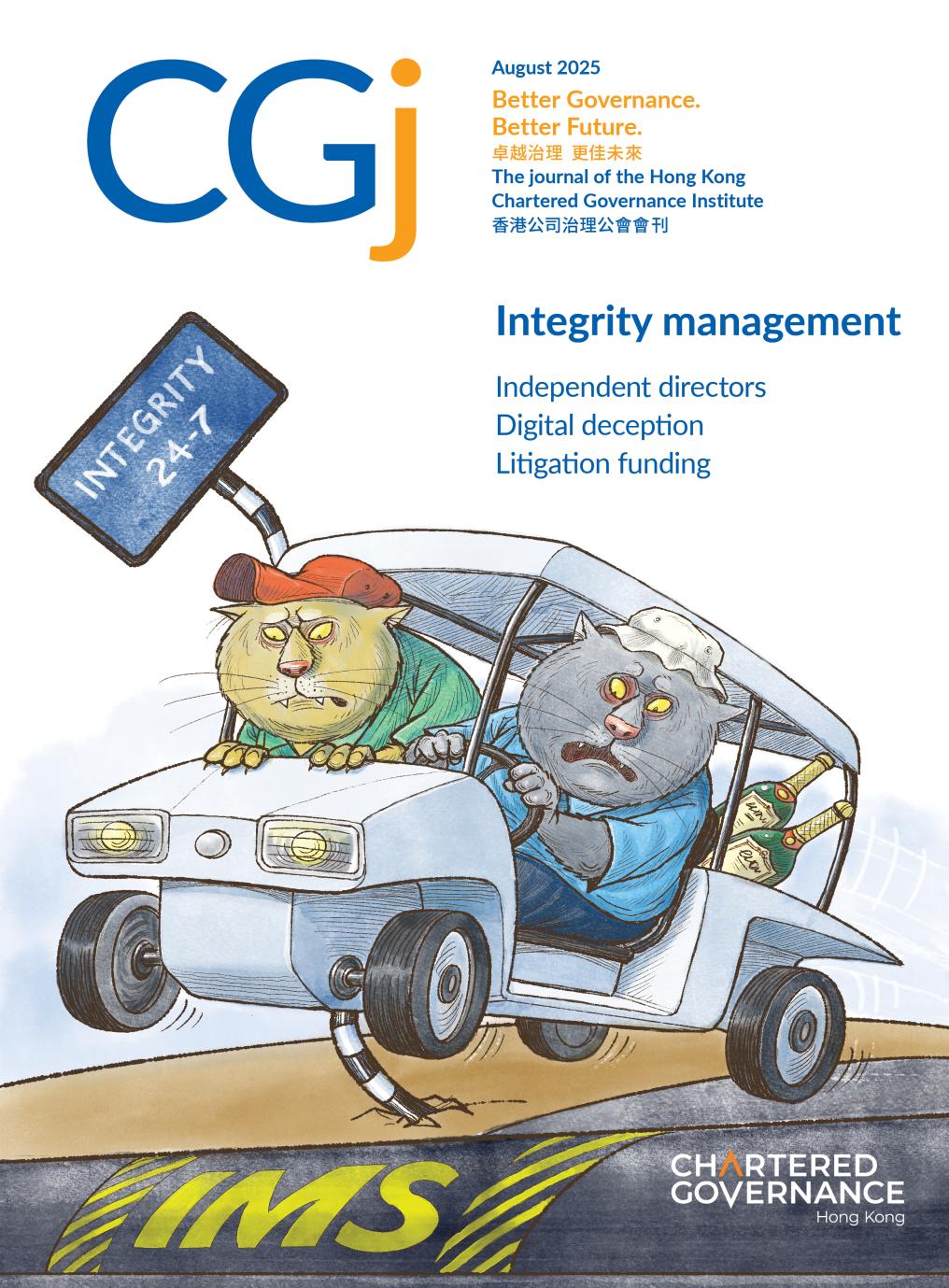
Litigation funding alternatives
Sammy Koo, Strategic Advisor, Des Voeux Chambers, and Founder, Strategic Key Ltd, explains how third-party funding and after-the-event insurance are enabling financially constrained claimants to pursue meritorious cases through the legal system.
Highlights
- third-party funding (TPF) supplies upfront capital for legal costs in exchange for a share of the proceeds, allowing claimants to pursue cases they might otherwise abandon
- after-the-event insurance protects claimants from adverse costs if they lose, often working hand-in-hand with TPF to create a complete riskmitigation structure
- with increasing global demand and evolving regulations, Hong Kong’s arbitration sector leads the way in embracing TPF, hinting at broader adoption in the future
Prohibitive litigation fees constitute a major obstacle to businesses, as well as to claimants fighting for justice or pursuing meritorious claims. Two financial mechanisms, namely third-party funding (TPF) and after-the-event (ATE) insurance, have emerged as potential solutions to the problem of litigation expenses that could transform the judicial landscape by making justice through legal channels more equitable and accessible.
Although both financial tools can serve to mitigate the financial burden of litigation, TPF plays a more important role in enabling access to justice by supplying upfront capital, whereas ATE insurance plays a more complementary role, covering unforeseen adverse costs in the event the claimant loses the case. Given the immense potential of these two financial systems, it is worth exploring their merits, mechanisms and future applications in relation to how they could potentially alter the justice system.
Regulatory landscape
The regulatory framework governing TPF and ATE varies across jurisdictions. TPF has been widely used around the world for years. However, it is still in its infancy in Hong Kong due to a lack of familiarity with the funding process on the part of both legal practitioners and the general public.
Currently, TPF for litigation is prohibited for third parties without justifiable interest from funding lawsuits for a share of the proceeds. Among the few exceptions, TPF in Hong Kong is mostly used for insolvency proceedings. In recent years, there have been major developments regarding TPF with significant regulatory progress. Since 1 February 2019, TPF has been permitted for arbitration and ancillary court proceedings, with outcome-related fee structure in arbitration being allowed since 16 December 2022.
There are a number of jurisdictions – such as England and Wales, parts of Australia, Canada and the US – that have noticeably fewer restrictions in terms of the types of case that can be funded. Some jurisdictions, such as the UK, have robust regulatory frameworks on TPF, while in other jurisdictions, legal guidelines are still in development. Similarly, the requirement for funders to disclose obligations and the limitations on the percentage of recovery also vary across jurisdictions. This creates a patchwork of global standards in relation to the implementation of TPF.
What TPF constitutes
TPF is an arrangement whereby the funder provides a financial resource for claimants or law firms that covers the litigation or arbitration costs in return for an agreed-upon portion of proceeds if the case is won. If the case is unsuccessful, the funder bears the financial loss. This ‘no cure, no pay’ allows claimants without financial means to pursue their meritorious claims that would not have been otherwise possible. The model ensures that clients with strong claims and limited resources are provided with funds, serving the interests of justice.
The process of applying for TPF involves the key stakeholders of the claimants, legal representatives, introducers and funders, and it begins when a claimant or their legal representatives seek financial resources from a funder, either directly or through an introducer. Conflict checks will be conducted and a non-disclosure agreement signed for the purpose of protecting the confidentiality of any information in relation to the case provided to the funder and/or the introducer.
The application of a funding request proceeds when the details of a given case’s legal merits, claim amount, estimated legal costs, key documents or evidence and the enforcement strategy of the claim, as well as any other essential information, have been submitted to the funder. After favourable initial assessment, funders will conduct a more thorough due diligence on the case’s merits, risks and expected recovery.
Meanwhile, a non-binding indicative offer of the funding terms may be provided by the funder to facilitate an early negotiation of the financial terms. An exclusivity agreement may also be signed during this negotiation period. Funders with in-house enforcement teams may also utilise their in-house resources to facilitate the tracing of assets and enforcement judgments in different jurisdictions, adding strategic value to the case. Once deemed satisfactory, funders and claimants enter a binding funding agreement outlining the key terms for providing the necessary funding, encompassing the funding amount, purpose, recovery or compensation for the funder, decision-making control, confidentiality, and termination grounds and mechanism, as well as the main rights and obligations of the funded parties and the third-party funder, among other essential provisions, to be reviewed and advised upon by lawyers to align with both the funder’s and the claimant’s interests. Once a funding agreement is signed, the legal expenses will be disbursed according to its terms.
It is typical for the funded party to remain in control of the legal proceedings and to choose its own legal representatives. The added advantage of TPF lies in the strategic advice and resources provided by the funders, in addition to the financial support. Leveraging their expertise in other areas, and because of their strategic guidance, the funders often enhance the likelihood of success. If the case is successful, the proceeds are distributed as per the terms of the funding agreement, whereas if it fails, the funder typically bears the full financial loss. The financial risk of commencing an action is thus shifted from the funded party to the third-party funder.
“This ‘no cure, no pay’ allows claimants without financial means to pursue their meritorious claims that would not have been otherwise possible.”
Relationship between TPF and ATE insurance
It is common practice for third-party funders to include ATE insurance in their offers to cover costs if the funded party loses the case. While TPF provides the funds to initiate legal action, ATE insurance can help mitigate the risk of adverse costs a claimant may incur when the court orders the claimant to pay the opposing party after losing the case, including but not limited to court fees and other legal expenses. The advantage of ATE insurance is that it is a bespoke policy that can be purchased after a dispute, indemnifying the claimant against the agreed-upon amount. In certain cases, the ATE insurance can also cover the claimant’s own legal fees, depending on terms. The premiums are calculated mainly based on the insurer’s risk assessment, the extent of coverage and the level of indemnity.
TPF and ATE insurance often work in tandem to create a comprehensive financial safety net for claimants, with TPF covering upfront legal costs, enabling claimants to initiate litigation, while ATE insurance protects against the downside risk of losing the case in a funding scenario. As such, many funders may require claimants to obtain ATE insurance as a condition of securing funding or, on the other hand, they might include premiums in the funding package. This practice speaks to the complementary relationship between the two financial mechanisms that are designed to protect both the claimant and the funder, thus allowing claimants to pursue meritorious claims without fear of financial risk.
In the case of liquidation scenarios, ATE insurance provides critical protection against the personal liability of liquidators for adverse costs, enabling them to focus on the case. Furthermore, law firms and funders also benefit from the risk reduction offered by this combination. ATE insurance mitigates against unexpected cost demands, while TPF allows firms to process cases without depleting their resources. When combined, these two financial tools can empower claimants to pursue complex and high-stakes cases that would not have been otherwise possible due to financial constraints. When used well, the combination can also level the playing field against well-resourced opponents.
“While TPF provides the funds to initiate legal action, ATE insurance can help mitigate the risk of adverse costs a claimant may incur.”
Other considerations
Their advantages notwithstanding, TPF and ATE insurance also pose challenges. The funder’s claim on the portion of the proceeds and the insurance premiums can drastically reduce the claimant’s final recovery – thus, claimants must carefully weigh the potential benefits against these costs. Ethical concerns may also arise regarding the funders’ influence on the case strategy or settlement decisions, which has the potential to compromise the attorney–client relationship. Communication with and the selection of reputable funders whose interests are aligned with those of the claimants is therefore of the utmost importance, requiring claimants to conduct thorough due diligence on the funder’s track record or reputation.
Another consideration is the complexity of TPF and ATE insurance agreements. Claimants must spend time understanding all the terms and their obligations in order to avoid disputes after the fact. Transparency and constant communication between the stakeholders is vital in preventing misunderstanding and may necessitate legal counsel to navigate the complex multiparty communications, incurring additional costs.
Future outlook
Despite the potential drawbacks, the TPF and ATE insurance markets are poised for growth, driven by regulatory reforms and investor interest. While TPF for litigation remains limited to only certain cases in Hong Kong, its use in arbitration and insolvency proceedings is increasing. Globally, there is also a trend in which jurisdictions are redefining regulations for TPF to facilitate access to legal proceedings. With the advent of AI tools, the claimants’ viability and funding applications can be streamlined to prioritise cases with the highest likelihood of success, potentially making TPF more common.
Ultimately, TPF and ATE insurance open a new avenue to pursue justice in the ever-evolving legal landscape by providing the means for those who are financially constrained to resolve disputes. Given the expanding global interest in funding and funding activity, steady growth in demand for TPF in Asia can be expected in the coming years, and its importance and prevalence will also undoubtedly increase.


